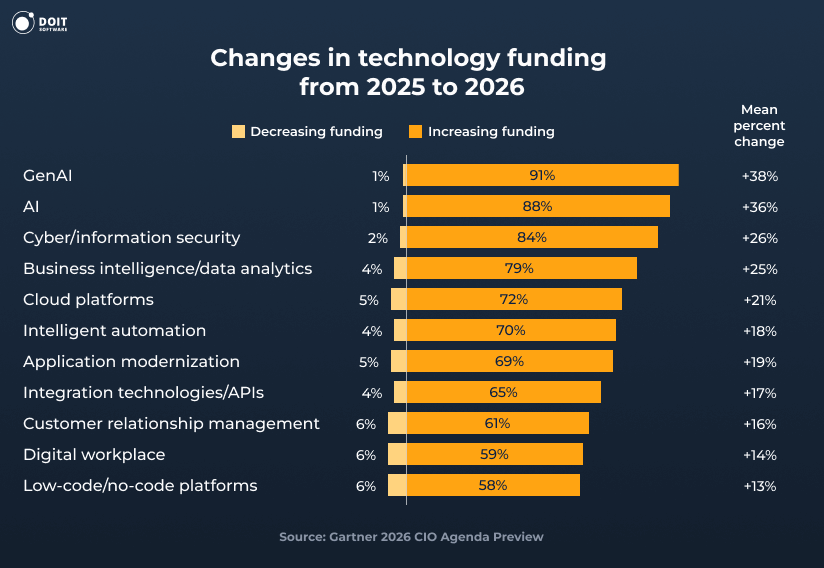 News
News
The pace of change in software is accelerating, and 2026 is already shaping up to be a defining year for engineering teams. As new technologies mature and established practices evolve, companies are rethinking how they design systems, manage talent, and scale digital products. The emerging software development trends for 2026 highlight a shift toward smarter automation, stronger security, and more efficient development environments. These trends are setting the tone for how forward-thinking teams will plan, build, and deliver in the months ahead.
Top 10 Software Development Trends To Keep In Mind For 2026
1. AI and LLMs as Everyday Coding Partners.
AI is reshaping how teams design, write, test, and refactor code. Large language models and task specific agents will move from autocomplete to orchestration. They will propose architectures, generate tests, suggest security hardening, and create migration plans. The impact is twofold. Routine work becomes faster, freeing engineers for higher value design and system thinking. Teams must also adopt guardrails and validation with human review, automated security scans, and clear governance patterns to prevent automated errors from being trusted blindly.
2. Low Code and Citizen Developers at Scale.
Low code and no code platforms will continue expanding into enterprise workflows and will allow product and operations teams to build real applications without heavy engineering cycles. This means faster internal tooling, more experimentation, and shorter time to prototype. For engineering leaders the implication is not replacement but composition. Platform teams will package governed building blocks, and engineers will focus on integration points, performance, and compliance rather than every UI form. Governance, observability, and reusable API contracts will act as the glue that keeps low code initiatives healthy.
3. Security as Code and DevSecOps Becoming Standard Practice.
Security is shifting left and deeper into pipelines. In 2026, vulnerability checks, SBOMs, secret scanning, and automated policy enforcement will be continuous rather than occasional. The rise of AI generated code increases urgency. AI can accelerate delivery but it can also spread insecure patterns quickly, so teams must embed security tests into AI assisted workflows and treat remediation as part of the CI pipeline. This trend creates a small but important culture change. Developers become responsible for measurable security metrics, and security teams evolve into engineers of prevention systems.
4. Cloud Native Maturity and Multi Cloud Pragmatism.
Cloud native practices have moved past hype and into everyday operations. By 2026, most teams will rely on cloud primitives, service meshes, and platform engineering to provide self service stacks. The smart move is not chasing every feature in one vendor’s ecosystem but building resilient systems that can operate across environments. FinOps and cost awareness will be essential planning elements. In practice, this means a stronger focus on platform APIs, golden paths for common tasks, and measurable SLOs that tie technical decisions to business outcomes.
5. Observability and Improved Developer Experience.
Observability is becoming a primary engineering discipline. Logs, traces, metrics, and error budgets guide daily decisions and reduce firefighting. Developer experience is following the same path. Internal tooling, curated scaffolds, and automated dependency upgrades will shorten onboarding and lighten cognitive load. Leaders will increasingly invest in quantifying flow through metrics like deployment frequency and lead time and quality through change failure rate rather than simply asking teams to be more productive.
6. Edge Computing and Distributed Processing.
Edge computing is expanding beyond CDNs and IoT and moving into latency sensitive services, real time personalization, and privacy focused workloads. Developers will need to think in terms of data locality, intermittent connectivity, and lightweight runtime footprints. Architectures will separate responsibilities between centralized control planes and decentralized execution points, which requires stronger contract testing and robust synchronization strategies. This unlocks new experience possibilities such as faster interactions and localized processing but it also demands disciplined operational playbooks.
7. Performance, Observability, and Sustainability.
Efficiency is becoming a strategic priority again. With cloud bills and carbon impact under scrutiny, teams will emphasize performant algorithms, optimized data flows, and right sizing of computers. Sustainable software practices such as measuring energy per request, eliminating wasteful polling, and consolidating batch windows will become part of architecture reviews. This reduces costs and improves user experience, so it is increasingly viewed as a board level conversation for any product at scale.
8. Polyglot Tooling and Safer Systems Languages.
Language choice is becoming more pragmatic. Teams will use languages that best support safety, latency, and maintainability. Enterprises will increase adoption of memory safe languages and runtime isolation for critical components where security and performance must not fail. At the same time, higher level languages and frameworks will continue providing productivity gains through stronger ecosystems and AI assistance. The result is more hybrid stacks where team strengths and runtime properties determine where code lives and how it is tested.
9. Automation of QA and CI Workflows.
Testing tools will increasingly use AI to generate test cases, create realistic mocks, and identify flakiness before releases. Automation does not eliminate QA roles. It elevates them. Test engineers will become strategists who design testing architecture, manage realistic data scenarios, and maintain reliability gates. Continuous verification with canary analysis, chaos experiments, and automated rollbacks will become a standard part of delivery. Teams that invest early here will ship faster and with far more confidence.
10. Governance, Ethics, and Disciplined AI Procurement.
As AI becomes standard in production systems, procurement and governance rise in importance. Organizations will define policies for model sourcing, data lineage, and acceptable use. Risk management spans intellectual property, bias, privacy, and supply chain vulnerabilities. Procurement teams and engineers will collaborate closely to define SLAs for model behavior, access controls for training data, and incident playbooks for model failures. Responsible AI becomes a continuous program embedded into delivery rather than a compliance checkbox.
Why Your Business Should Pay Attention to These Trends
Following these trends helps businesses in staying trendy as that is what matters a lot in recent times. It is about keeping your engineering decisions aligned with where technology is genuinely moving. When businesses follow the right software development shifts early, they gain stronger operational clarity, reduce technical debt, and build products that age well instead of becoming outdated in two years. These trends influence how fast your teams can deliver, how secure your systems remain, and how efficiently you can scale without burning resources. They also shape how competitive you appear in the eyes of customers and partners who expect modern, reliable digital experiences. By adopting the right practices at the right time, you position your business for sustainable growth, smoother releases, and a stronger technical foundation that supports bigger opportunities ahead.
Why This Matters to Us at Blue Coding
Blue Coding sees the above happening shifts happening in real time as our teams support clients across multiple industries and tech stacks. The rise of nearshore software innovation trends is shaping how we build distributed teams, streamline delivery, and help companies stay ahead of fast-moving changes in engineering. Our approach focuses on pairing strong technical expertise with the kind of flexibility modern product roadmaps demand. If you are planning your 2026 strategy and want a partner that understands both the technology and the operational side of global development, reach out to us. Contact us and we’ll help you move forward with clarity and confidence by also answering your queries on a complimentary strategy call!




